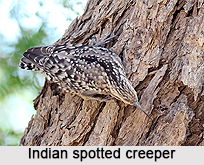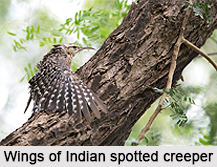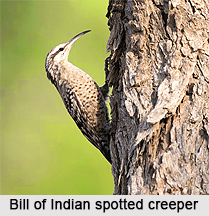 Indian Spotted Creeper is an Indian bird that bears a scientific name "Salpornis spilonotus" is the member of Salpornithinae.
Indian Spotted Creeper is an Indian bird that bears a scientific name "Salpornis spilonotus" is the member of Salpornithinae.
Category of Indian Spotted Creeper
Indian Spotted Creeper is a small passerine bird, which is a member of the subfamily Salpornithinae which is placed along with the tree creepers in the family of Certhiidae.
Structure of Indian Spotted Creeper
Indian Spotted Creeper is a small bird that has a marbled black and white plumage that makes it difficult to spot as it forages on the trunks of dark, deeply fissured trees where it picks out insect prey using its curved bill.
Habitat of Indian Spotted Creeper
Indian Spotted Creeper is found in patchily distributed localities mainly in the dry scrub and open deciduous forests of northern and central peninsular India. It does not migrate. Their inclusion along with the tree creepers is not certain and some studies find them more closely related to the nuthatches while others suggest a close relation to the wall creeper. They lack the stiff tail feathers of tree creepers and do not use their tail for supporting them while creeping vertically along tree trunks. Indian Spotted Creeper is found mainly in habitats having trees with deeply fissured bark including those of Acacia, Diospyros, Tectona and mango.
 Plumage of Indian Spotted Creeper
Plumage of Indian Spotted Creeper
Indian Spotted Creeper has grey and white spotted and barred plumage, clearly different from the Tree Creepers of the subfamily Certhiinae.
Body Weight of Indian Spotted Creeper
Indian Spotted Creeper weighs up to 16 grams, twice as much as tree creepers of similar length (up to 15 cm). The Indian Spotted Creeper has a thin pointed down-curved bill, a bit longer than the head, that it uses to extricate insects from bark, but it lacks the stiff tail feathers which tree creepers use to prop themselves on the vertical surface of tree trunks. They have a whitish supercilium contrasting with a dark eye stripe and white on the throat. The wing is long and pointed with a highly reduced first primary feather. The tail has twelve feathers and is square tailed. The sexes are identical in plumage.
Behaviour of Indian Spotted Creeper
Indian Spotted Creeper is found singly or in mixed species flocks, foraging on the trunks of trees. It has an undulating flight and moves up the trunk, starting off from near the base, sometimes on horizontal branches. When flying down to the base of a tree, it has the clumsy appearance of a quail landing in grass. They resemble nuthatches in the way they work up and down the trunk and do not work in the spiral manner of tree creepers. The tail is held away and sometimes clings upside down. They feed on small insects and spiders on the bark.
 Call of Indian Spotted Creeper
Call of Indian Spotted Creeper
The calls of Indian Spotted Creeper are a series of rising tui-tui-tui notes and the song is a plaintive series of whistled notes tsip-tsee tuu tuui-tuwee having the quality of that of sunbird.
Breeding Season of Indian Spotted Creeper
The breeding season of Indian Spotted Creeper is February to May.
Nests of Indian Spotted Creeper
The nest is a cup made of roots and stalks placed at the junction of a horizontal branch and the vertical trunk, often near a knot or other outgrowth that makes it very difficult to spot. The nest walls are pliant and soft but strong.
Eggs of Indian Spotted Creeper
The usual clutch of Indian Spotted Creeper consists of two eggs, which are greenish or grey, spotted darker brown and blotched pale. The female alone incubates the eggs and is fed by the male with which it keeps in contact with a twittering call. Both parents take part in feeding the chicks.



















